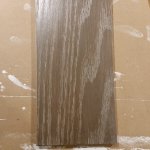I'm making new legs for my bed and using some scrap red oak for stock. I've got everything glued up, cut, planed, and ready for finishing. So far, I've put one coat of oil on them. Looks nice - lots of flecking and rays.
I was thinking about spicing things up a bit, and doing a cerused finish - but what to use?
I was thinking I could do the following:
1 more coat of oil
Coat of sanding sealer
Fill pores with something white (plaster? white paint?)
Remove white stuff from non-pores
Coat or two of shellac/lacquer.
I've never done a cerused finish before, so I'd be interested to know what other folks do.
-Adam
I was thinking about spicing things up a bit, and doing a cerused finish - but what to use?
I was thinking I could do the following:
1 more coat of oil
Coat of sanding sealer
Fill pores with something white (plaster? white paint?)
Remove white stuff from non-pores
Coat or two of shellac/lacquer.
I've never done a cerused finish before, so I'd be interested to know what other folks do.
-Adam

